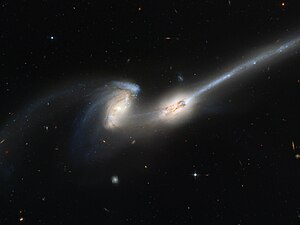Mice galaxies

The Mice galaxies (NGC 4676) are two spiral galaxies in the constellation Coma Berenices. About 290 million light-years away,[1] we see them as they began to collide and merge. Their name refers to the long tails produced by tidal action, which is the relative difference between gravitational pulls on the near and far parts of each galaxy. They are members of the Coma cluster, so the galaxies may have collided before, and will continue colliding until they merge.
The galaxies were photographed in 2002 by the Hubble Space Telescope.[2]
References[change | change source]
